Missionary Travels in Pen & Print (2)
Cite (MLA): Livingstone, Justin D. "Missionary Travels in Pen & Print (2)." Jared McDonald and Adrian S. Wisnicki, eds. In Livingstone's Missionary Travels Manuscript. Justin D. Livingstone and Adrian S. Wisnicki, dirs. Livingstone Online. Adrian S. Wisnicki and Megan Ward, dirs. 2019. Web. http://livingstoneonline.org/uuid/node/5f11cfdd-21cf-4bd4-bc22-2c2d9e7e4456.
This page, the second of a two-part essay, engages in comparative analysis of Livingstone’s Missionary Travels in manuscript (1857bb, 1857cc, 1857dd) and published form (1857aa). In doing so, it identifies two major patterns of revision and redaction that occurred between draft and print. First, the essay demonstrates that Missionary Travels was subject to a process of sanitisation following the conventions of polite publishing; through this process, content that a genteel audience might have considered vulgar or improper was excised before publication. Second, the essay argues that redactions of contentious material on the Transvaal Voortrekkers and the Cape Frontier Wars served to depoliticize the book in the interests of avoiding public controversy. Read the first part of the essay here.
4. Depoliticization: The Cape Frontier Wars Top⤴
Missionary Travels was yet more profoundly shaped by critical redactions concerning the Cape Frontier Wars. Inspection of the manuscript reveals that Livingstone's comments on these politically contentious conflicts were subject to the single largest act of redaction. A lengthy section on "The Cape Colony" (1857bb:[197]-[227]), which contains some of Livingstone's most radical material, was removed in full before the book made it to press. In this extensive passage, Livingstone is considerably more forthright in his criticisms of Cape settlers, colonial governance, and colonial violence than he would be in his eventual publication.
From the 1770s to the 1870s, colonial encroachment in South Africa's Eastern Cape resulted in nine major conflicts between the AmaXhosa and Europeans (first the Dutch and then the British) and the eventual dispossession of AmaXhosa territories. Livingstone was resident as a missionary in southern Africa during both the Seventh Frontier War of 1846-47 (also known as the War of the Axe) and the Eighth Frontier War of 1850-53 (also known as the War of Mlanjeni) (Ross 2003).
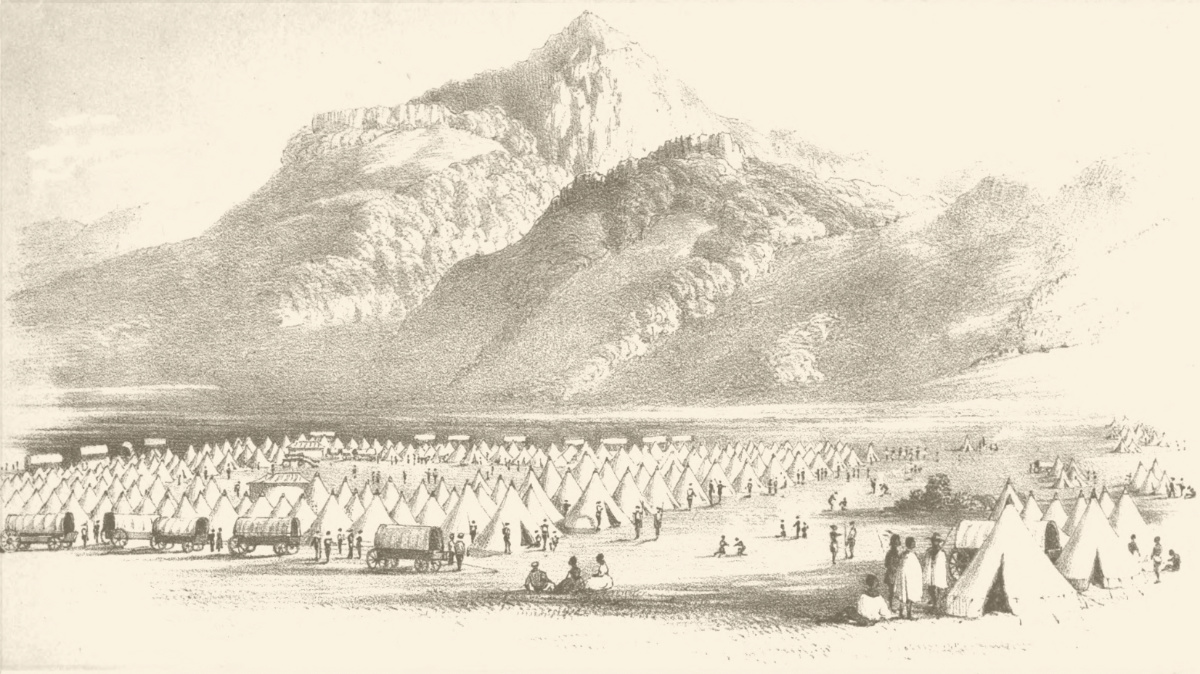
Camp Under the Amatolas. Illustration from W. R. King, Campaigning in Kaffirland or Scenes and Adventures in the Kaffir War of 1851-2, second edition (London: Saunders and Otley, 1855), frontispiece. Courtesy of the Hathi Trust. This image shows a military encampment during the Eighth Cape Frontier War. The Amatola Mountains, in South Africa’s Eastern Cape, were the setting for multiple encounters between British and AmaXhosa forces in the Seventh, Eighth, and Ninth Cape Frontier Wars.
Livingstone studied these conflicts, became highly critical of colonial activities, and threw his support behind the AmaXhosa when visiting Cape Town in 1852. Livingstone also attempted to disseminate his support publicly by writing an article for the British Quarterly Review, which was rejected for publication by the editor, Robert Vaughan (Petrusic 2004:27, 20, Ross 2002:70-74, Livingstone 1852-53; this essay remains unpublished and is held in the National Archives of Zimbabwe).
In discussion of this unpublished essay and of Livingstone's private correspondence and journals, some critics suggest that had these ideas appeared in print, Livingstone "would have been open to a charge of treason" (Petrusic 2004:30). Although this claim is perhaps overstated, it is striking that Livingstone initially saw Missionary Travels as renewed opportunity to make a public intervention on the Cape Frontier Wars and on the uprising of Khoekhoe during the War of Mlanjeni known as the Kat River Rebellion. Since the extended passage on "The Cape Colony" has not been published prior to this edition and has only received preliminary critical attention (Livingstone 2014:38-41), it is worth exploring in some detail.
▲ 4.1. "Glenelg" and "D'Urban" Policies
Livingstone's repressed passage on "The Cape Colony" appears in the ninth section of the Missionary Travels manuscript and runs to thirty pages in length (1857bb:[197]-[227]). In its opening paragraphs, Livingstone attempts to communicate concerns about Cape politics in a fashion that would appeal to the nationalistic sensibilities of his British audience. Before entering into the particulars of the Frontier Wars, he prefaces his discussion by commending British character and conduct: "English colonists" are "unquestionably the best in the world," writes Livingstone; the "British merchant" has a "world wide reputation […] for honest determination to fulfill his engagements," and the "English Government" is characterised by its "general willingness to make considerable sacrifices for, and to acknowledge the duty of their civilization" (1857bb:[198]-[199]).
Following this romanticized introduction, however, the passage quickly shifts into more critical tenor. Despite paying tribute to colonial fair play, Livingstone is clear that the Frontier conflicts are an intractable problem: "Millions of Pounds are cheerfully paid out of the British Treasury for the defence of the Colonial Frontier, but notwithstanding the most lavish expenditure of money and men there never is the smallest probability that a future outbreak will be prevented" (1857bb:[200]).
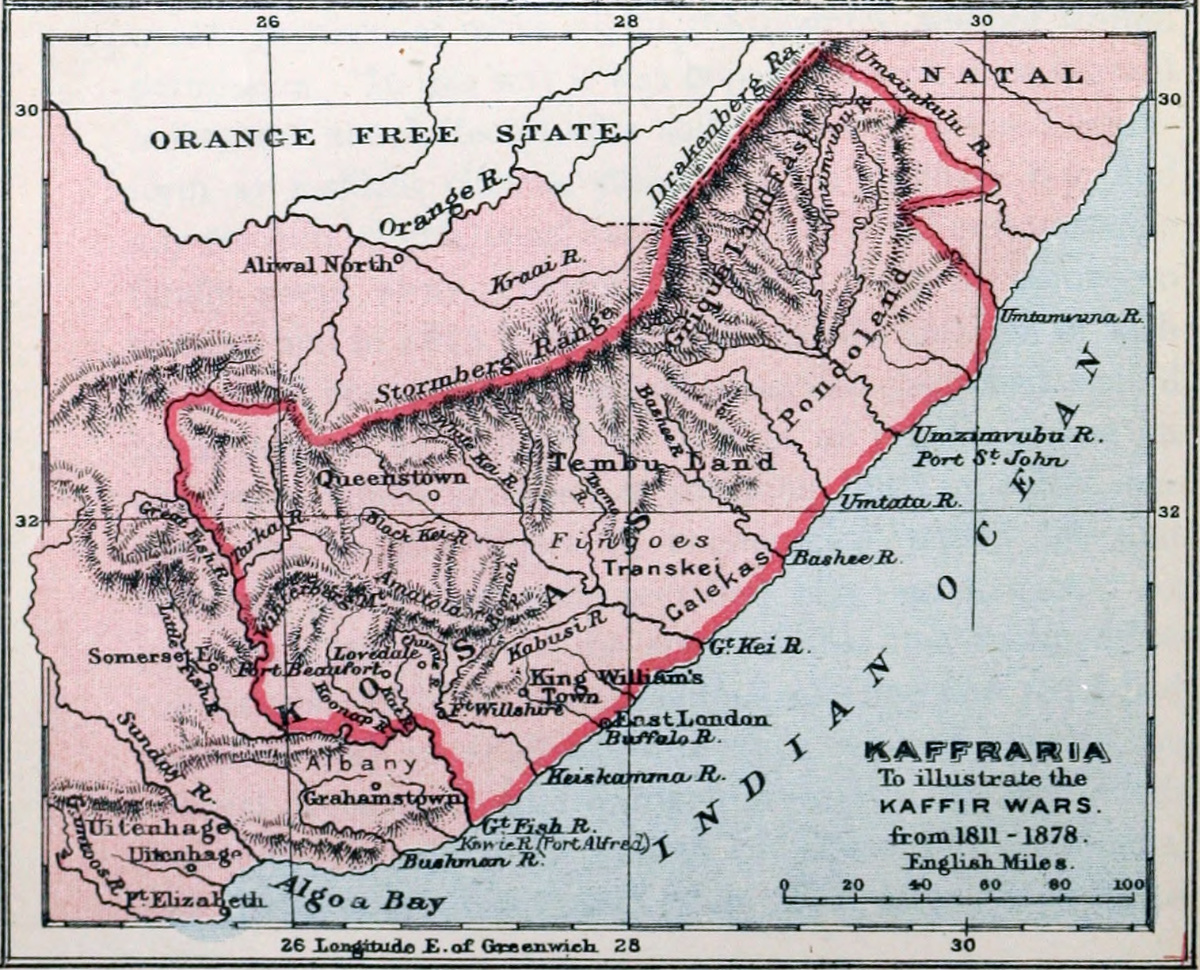
Map to Illustrate the Kaffir Wars. Map from C. P. Lucas, A Historical Geography of the British Colonies, 6 vols (Oxford: Clarendon, 1897), 4:opposite 149. Courtesy of the Internet Archive. This map shows the geographical area, in present-day Eastern Cape province, in which the Cape Frontier Wars were fought between the late-eighteenth and late-nineteenth centuries. The lands inhabited by the AmaXhosa were referred to historically as Kaffraria by European settlers.
Promising only a "rapid sketch" of the "great Kaffir difficulty," Livingstone's starting point is with colonial policy. He draws inspiration from the former colonial secretary, Baron Glenelg, and the former Cape Governor, Sir Benjamin D'Urban, to make a distinction between two sets of principles that had guided intervention in the Eastern Cape: the "Glenelg" and "Durban" policies (1857bb:[200]-[201]). During the Sixth Frontier War (1834-35), Glenelg had collided with D'Urban over the governor's military conduct against the AmaXhosa, which had roused humanitarian opposition in Britain. Glenelg, who was himself involved in humanitarian circles, refused to recognise the annexation of Queen Adelaide Province and ultimately removed D'Urban from his post (Martin 2008, Etherington 2001:245).
In characterising Glenelg's approach as a "philanthropic policy," Livingstone makes it clear where his sympathies lie. This system, argues Livingstone, "presupposed [the AmaXhosa] had some sort of natural title to their lands," and had been highly effective in prolonging "[t]he interval between Kaffir outbreaks." In contrast, Livingstone claims, D'Urban's "severer system" had essentially sought to incite the "Dutch Colonists to turn out and exterminate the Caffers" (1857bb:[200]-[201]).

Portrait of Sir Harry Smith. Illustration from Geo. E. Cory, The Rise of South Africa: A History of the Origin of South African Colonisation and its Development Towards the East from the Earliest Times to 1857, 6 vols (London: Longmans, Green and Co., 1930), 5:opposite 98. Courtesy of the Internet Archive. Sir Harry Smith was Governor of the Cape of Good Hope and Lieutenant-General of the Cape forces between 1847 and 1852.
Livingstone saw the "cancelment of the rational Glenelg policy" as a defining moment in recent Cape politics and was deeply critical of events that had followed the turn to a more aggressive policy. Alluding to the conclusion of the Seventh Frontier War, Livingstone condemns the antagonistic conduct of a colonial official who had "elected himself the paramount chief of Caffreland" and ignored the fact that that he was "dealing with the most devotedly loyal people on earth" (Livingstone 1857bb:[204], [202]). Clearly commenting on the Cape Governor, Sir Harry Smith, who had notoriously humiliated AmaXhosa leaders and proclaimed himself "supreme chief, or inkosi inkulu" in 1847 (Vetch 2008a), Livingstone argues that for "any one acquainted with the political constitution of the South African tribes no step could have been devised better for rousing the wrath of the entire Caffre people" (1857bb:[202]).
For Livingstone, Smith's military excursions during the subsequent Eighth Frontier War continued the "D'Urban policy." In his earlier service as a commanding officer during D'Urban's tenure at the Cape, Smith had pursued a course of action that was "as severe as the most bloody minded could desire" (Livingstone 1857bb:[203]-[204]). Livingstone thus uses inflammatory language to describe recent encounters on the Eastern Cape frontier as a brutal and impracticable effort to "exterminate" the AmaXhosa; as he caustically remarks, the misguided "fighting policy" can only result in "permanent peace when we have depopulated all the country between Graham's town and Timbuctu" (1857bb:[204]).
▲ 4.2. AmaXhosa Perspectives
In the context of the "ridiculous mistakes" in European policy cited above, Livingstone argues that a "remedy" can only be found through an investigation of "the causes of the Caffre wars" (1857bb:[204]). He offers three explanations for ongoing outbreaks, purportedly to allow his readers to decide between them. First, Livingstone notes, there are those who place the blame squarely on the AmaXhosa themselves:
Some aver that Caffir Wars have been rendered necessary by the restless thievish propensities of our savage neighbours and not from any injustice or aggression either on the part of the government or of the inhabitants of the Frontier. (1857bb:[205])
Second, Livingstone observes that critics of Cape land politics interpreted the conflicts differently and held colonial settlers and intrusion into AmaXhosa territories to be responsible. Expressing the perspectives of LMS missionaries such as James Read and the Cape superintendent John Philip, Livingstone writes:
it is a fact true of this as of other colonies that the native population becomes worse and not better from its contact with civilization and a professedly Christian people adding that the grasping encroachments of the white man from year to year on the native lands is rather an unlikely mode of teaching the Caffirs that honesty is one of the virtues. ( 1857bb:[205])
Finally, Livingstone completes "the catalogue of alleged causes" by attempting to convey what "the Caffres themselves say." To do so, he quotes from a speech by the AmaXhosa paramount Ngqika, Mgolombane Sandile, who had been a leader in both the Seventh and Eighth Frontier Wars. Sandile's speech goes well beyond the critique of colonial influence offered by missionaries and questions the entire logic of the colonial enterprise. He challenges British colonialism in terms that a European audience would recognise by grounding his complaint in an appeal to the Bible. For Sandile, colonial violence is not justified in scripture: "No white man is without a book – Is it God who gave this book bids him think of blood" (qtd. Livingstone 1857bb:[206]).
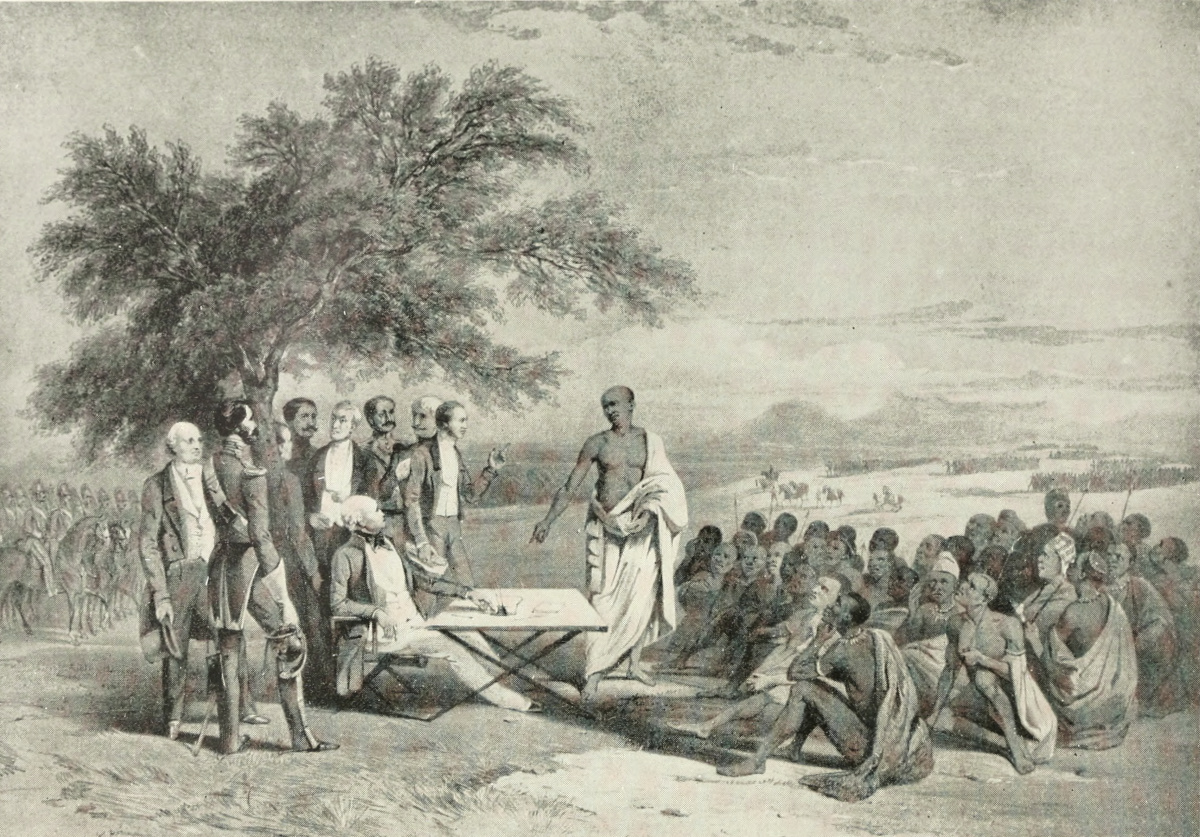
Conference Between Col. Hare and Sandilli, from Sketch by Sir Harry Darrell. Illustration from Geo. E. Cory, The Rise of South Africa: A History of the Origin of South African Colonisation and its Development Towards the East from the Earliest Times to 1857, 6 vols (London: Longmans, Green and Co., 1926), 4:frontispiece. Courtesy of the Internet Archive. This scene depicts negotiations between Colonel John Hare and the AmaXhosa chief, Sandile, which took place in early 1846 prior to the outbreak of the Seventh Cape Frontier War. The illustration, which portrays Sandile as a "noble savage," provides insight into mid-nineteenth century representations of the AmaXhosa. More specifically, the imagery connects Sandile to classical antiquity, a link that dignifies the AmaXhosa but also portrays them as a people belonging to an earlier period of history (see Lester 2001:55).
Sandile defends AmaXhosa sovereignty, moreover, by invoking divine sanction for natural borders and political authority. "God made a boundary by the sea," he contends, "and white men cross it to rob us of our country." Territorial dispossession and the imposition of colonial rule, Sandile's speech suggests, are in violation of natural law: "Is it God who sent the Englishman across the sea to take our country – Is it God who created him bids him come and rule over the chiefs of other countries" (qtd. Livingstone 1857bb:[206]).
By including a portion of Sandile's speech in his draft of Missionary Travels, Livingstone gives expression to a powerful document of AmaXhosa nationalism and anti-colonial resistance. Having done so, Livingstone feels it necessary to append a disclaimer designed to present himself as an impartial commentator. "Now these assertions," he writes, "possess so much of the recriminatory character one cannot feel confidence in either" (Livingstone 1857bb:[207]).
Yet although he tempers the force of Sandile's arguments in consideration of his intended audience, Livingstone by no means discredits or disavows them. He makes it clear that an unbiased perspective is even less likely to emerge from the portion of the settler community who "benefitted by Caffre wars;" they could not be expected to give "an opinion worth a straw" (Livingstone 1857bb:[207]).
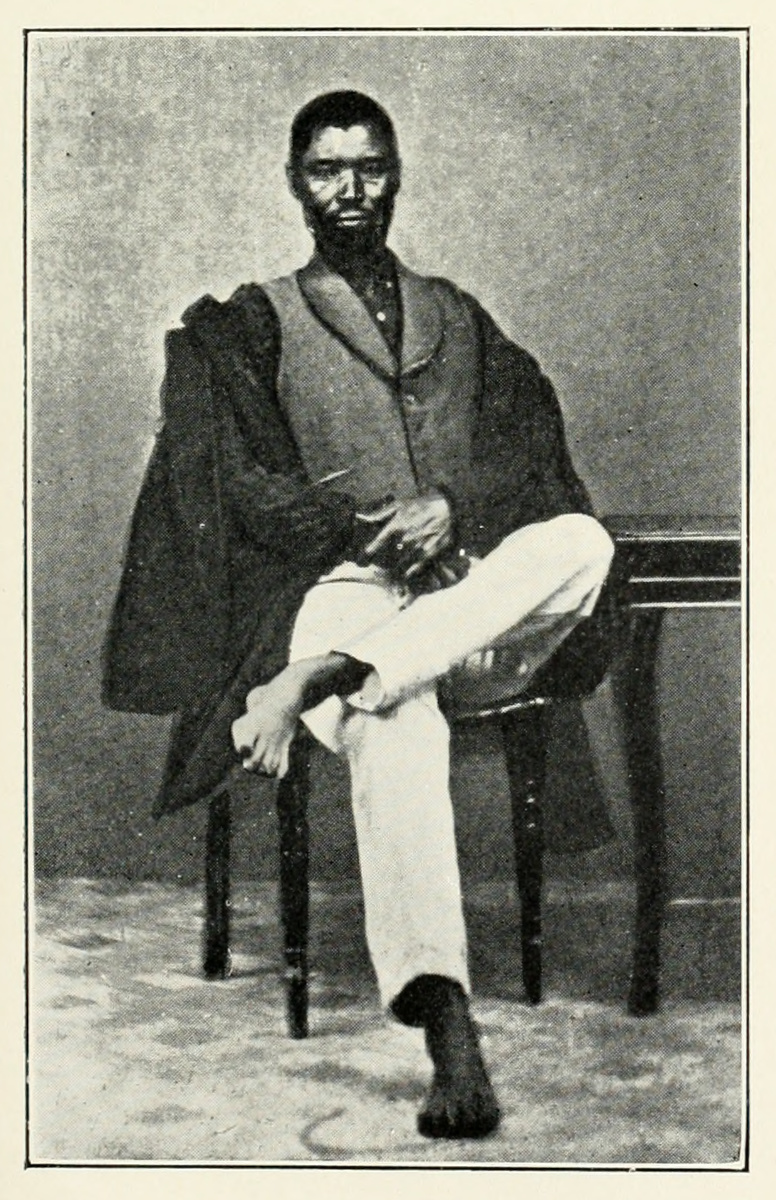
Chief Sandilli. Illustration from Geo. E. Cory, The Rise of South Africa: A History of the Origin of South African Colonisation and its Development Towards the East from the Earliest Times to 1857, 6 vols (London: Longmans, Green and Co., 1930), 5:opposite 298. Courtesy of the Internet Archive. Sandile was paramount chief of the Ngqika AmaXhosa and a major leader of AmaXhosa forces in the Seventh, Eighth, and Ninth Cape Frontier Wars. He was killed in conflict in 1878, during the Ninth Frontier War (1877-79).
Livingstone might make some effort not to appear partisan, but there is little mistaking the overwhelming direction of the passage. He is critical of both the Grahamstown colonists – particularly the merchant class – who profited in trade during the Frontier Wars and the British government who sponsored military action.
Grahamstown had been established in 1812 as a defensive garrison on the frontier of AmaXhosa territory. By Livingstone's day, the settlement had developed into the capital of the Cape Colony's Eastern Province (Vernal 2012:85-87). For Livingstone, however, the town's merchants had become a "moneyed community" – a "Shopocracy" – which had "grown great by Caffre wars" and had made "the blood of the English soldier profitable" (1857bb:[208], [217], [210]). Britain, meanwhile, helped to perpetuate the conflicts: the "mother country," Livingstone argues, had "gone as far in gratifying their whim for Kaffir wars as the most leech-like portion of humanity could desire" (1857bb:[211]).
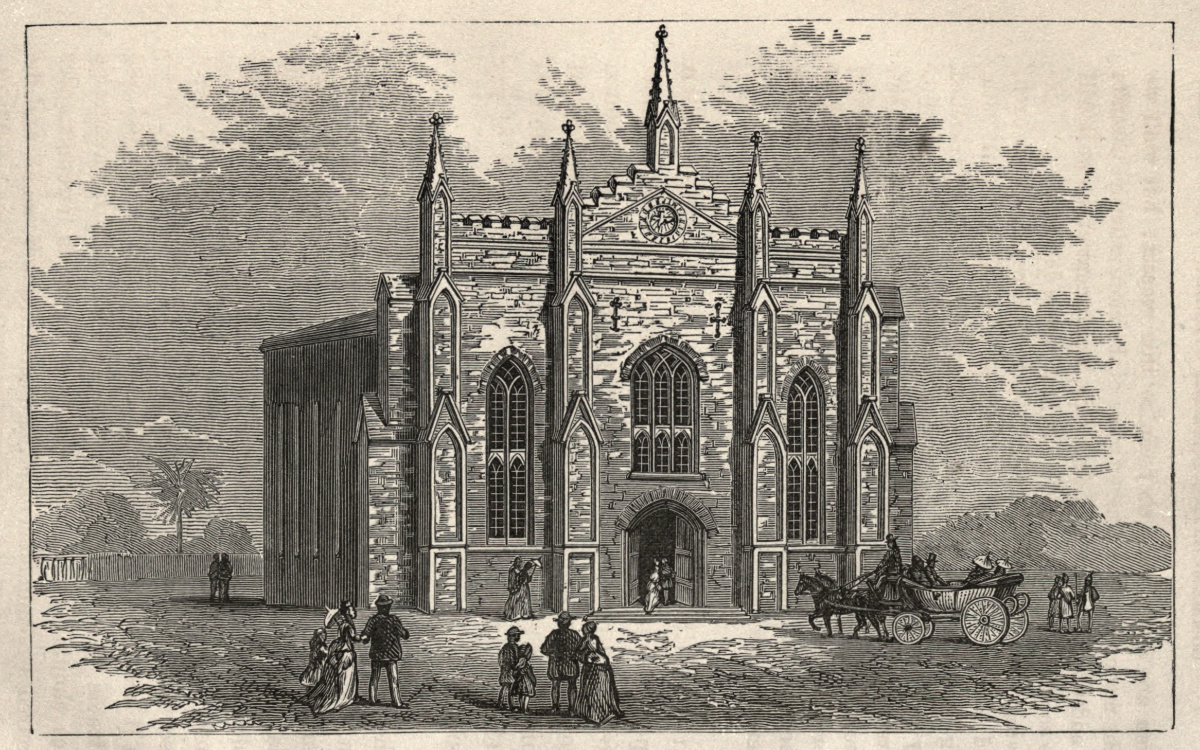
Commemoration Chapel, Graham’s Town. Illustration from Memoir of the Rev. William Shaw, Late General Superintendent of the Wesleyan Missions in South-Eastern Africa (London: William Nichols, 1875), opposite 217. Courtesy of the Internet Archive. Construction of this Methodist chapel in Grahamstown was begun in 1845 to mark the silver jubilee of British settlement of Albany in South Africa’s Eastern Cape. Building was delayed by the Seventh Frontier War but was completed in November 1850.
Livingstone's repeated insistence is on the importance of considering AmaXhosa perspectives. He not only gives voice to Sandile's political challenge, but argues that consultation of the AmaXhosa is critical to avoiding further outbreaks: "We have always but one side of the question in Caffre difficulties […] perhaps collision might be avoided altogether if they were allowed a voice in the solution of the difficulty" (Livingstone 1857bb:[208]-[209]). Parts of the suppressed passage even resound like an impassioned appeal for public enquiry: "[B]y all means let us hear both sides of the question – What do the Caffres say? [...] Let us hear both sides and not go blundering on […] Let us have a ‘Times commissioner [i.e., an investigative journalist]'" (Livingstone 1857bb:[210]; also see 1857bb:[227]).
In drafting the passage on the Cape Frontier Wars, Livingstone thus made sure to note the complexity of their underlying causes and to present multiple interpretations of the prolonged collisions. There is no doubt, however, that he designed his lengthy assessment to privilege and prioritise the AmaXhosa voice, which he felt had not yet been granted the wider audience it deserved. Although critics should always consider such "ventriloquised" non-western voices with a degree of caution (Youngs 2002:164), recourse to Sandile's perspective allowed Livingstone to provide a major challenge to the partial colonial commentary on the Cape Frontier Wars that circulated in Britain and the Cape Colony.
▲ 4.3. The Kat River Rebellion
In commenting on the Cape Frontier Wars, Livingstone was not only concerned with injustices to the AmaXhosa. He was also preoccupied by the Khoekhoe community resident at the Kat River Settlement, some of whom had joined the AmaXhosa in rebellion during Mlanjeni's War despite having served in British forces during previous conflicts. In the repressed passage on "The Cape Colony," Livingstone sets out to defend this community and justify the unexpected revolt.
To do so, Livingstone pays tribute to the Khoekhoe's military service on the eastern frontier. The Kat River Settlement, he points out, had been established by Sir Andries Stockenstrom "for political purposes […] the defence of the Frontier." The residents had performed their task well, having "turned out boldly to fight the Kaffirs […] in successive wars – remained in the field often without pay and returned to their families in rags" (Livingstone 1857bb:[222], [224]). Livingstone is correct in his assessment; the Khoekhoe were vastly over-represented in the colonial forces during both the Sixth and Seventh Frontier Wars, with the majority of able-bodied men conscripted into service (Petrusic 2004:35).

Topographical Sketch of the Kat River Settlement and Adjacent Country. From the Map Compiled From the Best Authorities by M. Woodifield, C. E., Sworn Government Surveyor, May, 1852. Illustration from Geo. E. Cory, The Rise of South Africa: A History of the Origin of South African Colonisation and its Development Towards the East from the Earliest Times to 1857, 6 vols (London: Longmans, Green and Co., 1930), 5:opposite 326. Courtesy of the Internet Archive. This sketch delineates the geography of the Kat River Settlement and surrounding regions as they appeared in the early 1850s, around twenty years after the settlement was established.
Livingstone also places the blame for the end of Khoekhoe loyalty squarely on the Cape government. Before the outbreak of the Eighth Frontier War, he argues, the Kat River Settlement had been "most unjustly deprived of their arms" (Livingstone 1857bb:[222]). In 1848, Sir Harry Smith had stripped the settlement of the government guns that had first been issued in 1830. Following the annexation of Victoria district, the Kat River was no longer the first line of defence on the Cape frontier and so had diminished in military significance (Kirk 1973:422). While Livingstone perhaps attributes too much explanatory weight to the recall of weapons – arguing that it left the settlement "unable to do otherwise" but "join in the ranks of the Kaffirs" when "surrounded by the enemy" – he is right to detect that enforced decommissioning was a legitimate grievance (1857bb:[222]).
Additionally, Livingstone complains that the Khoekhoe had been divested of "some of their lands" (1857bb:[222]). Certainly, land deprivation was a pressing issue in the Kat River Settlement and a major factor in the rebellion (Kirk 1973:426). Since its establishment in 1829, the settlement's population had increased significantly. Dispossessed peoples from elsewhere in the colony – including Mfengu, Basotho, and coloured communities – had relocated to the Kat River Settlement. With the contraction of AmaXhosa territories as a result of frontier disputes, increasing numbers of AmaXhosa were also migrating to the settlement (Kirk 1973:417, Petrusic 2004:36).
| (Left; top in mobile) Sir Andries Stockentrom, Bart. (Right; bottom) Sir Benjamin Durban. Illustrations from Geo. E. Cory, The Rise of South Africa: A History of the Origin of South African Colonisation and its Development Towards the East from the Earliest Times to 1857, 6 vols (London: Longmans, Green and Co., 1919), 3:opposite 340, opposite 102. Courtesy of the Internet Archive. Sir Andries Stockenstrom was Lieutenant-Governor of the Eastern Cape between 1836 and 1839. Sir Benjamin D’Urban was Commander-in-Chief and Governor of the Cape of Good Hope between 1833 and 1837. |
The Kat River community was also being threatened by colonial expansion. Under Governor Benjamin D'Urban in the 1830s and Governor Harry Smith in the late 1840s, the colonial government had alienated holdings in and around the Kat River Settlement area and awarded them to white farmers (Kirk 1973:417, 420). Such measures reduced the common pasturage available to the Khoekhoe and constricted the boundaries of the settlement.
Livingstone considered colonial encroachments on the Kat River Settlement to be directly responsible for the rebellion. The expense of curbing this uprising, he complains, had to "be paid by the mother country because certain proteges wished to possess the Kat river settlement". Livingstone defends Khoekhoe land rights by arguing that such colonial incursions displayed "the unblushing greediness of this small portion of our empire" (1857bb:[223]).
In an appeal that he hopes will resonate with British readers, Livingstone also suggests that the territorial dispossession of the Khoekhoe is a betrayal of imperial trusteeship – the principle that imperial power should be used for the benefit of subject peoples (see Bain 2003 on trusteeship). The alienation of settlement lands, he writes, is "peculiarly odious" because of "the altogether un-English wish displayed for aggrandizement at the expense of the degraded races in their vicinity" (1857bb:[223]).
▲ 4.4. The Trial of Andries Botha
Part of Livingstone's motivation to vindicate the Kat River community stemmed from its long association with the London Missionary Society. James Read, who spent fifty years working at the Cape, had established a congregation in the settlement in 1829 (McDonald 2010:516). In the aftermath of the rebellion, the LMS had faced public accusations in the Cape of having fomented unrest. But Livingstone rejected these claims out of hand: in the repressed passage on "The Cape Colony," he dismisses the idea "that the missionaries were the originators of the Hottentot rebellion" and argues that "not a syllable could be elicited tending in any way to shew complicity of any missionary of any sect whatever" (1857bb:[221]-[222]).
Criticisms of the LMS influence found focus in the post-rebellion trial of Andries Botha, a missionary convert and a veldcornet of the Kat River (i.e., a militia officer charged with upholding law and order in a particular district), who was sentenced for his supposed role in leading the revolt. Livingstone personally felt that the treason trial was motivated in part by Botha's connection with the missionary society:
A Hottentot officer named Botha was fixed upon as apparently deeply implicated in the late rebellion & war – and as he was known to be connected with some missionaries at the Kat river his trial was loudly demanded as certain to draw out in the most convincing way the fullest evidence of their complicity – (1857bb:[218]-[219])
Having attended all eight days of Botha's hearing, Livingstone considered the trial to be nothing more than a sham. He emphasises the veldcornet's long history of loyal service by citing Sir Andries Stockenstrom's testimony "that for forty years [Botha] had been 'a most efficient officer' in the Queens [sic] service and had been 'the chief agent in bringing one at least of the Kaffir wars to a successful close'" (Livingstone 1857bb:[219]).
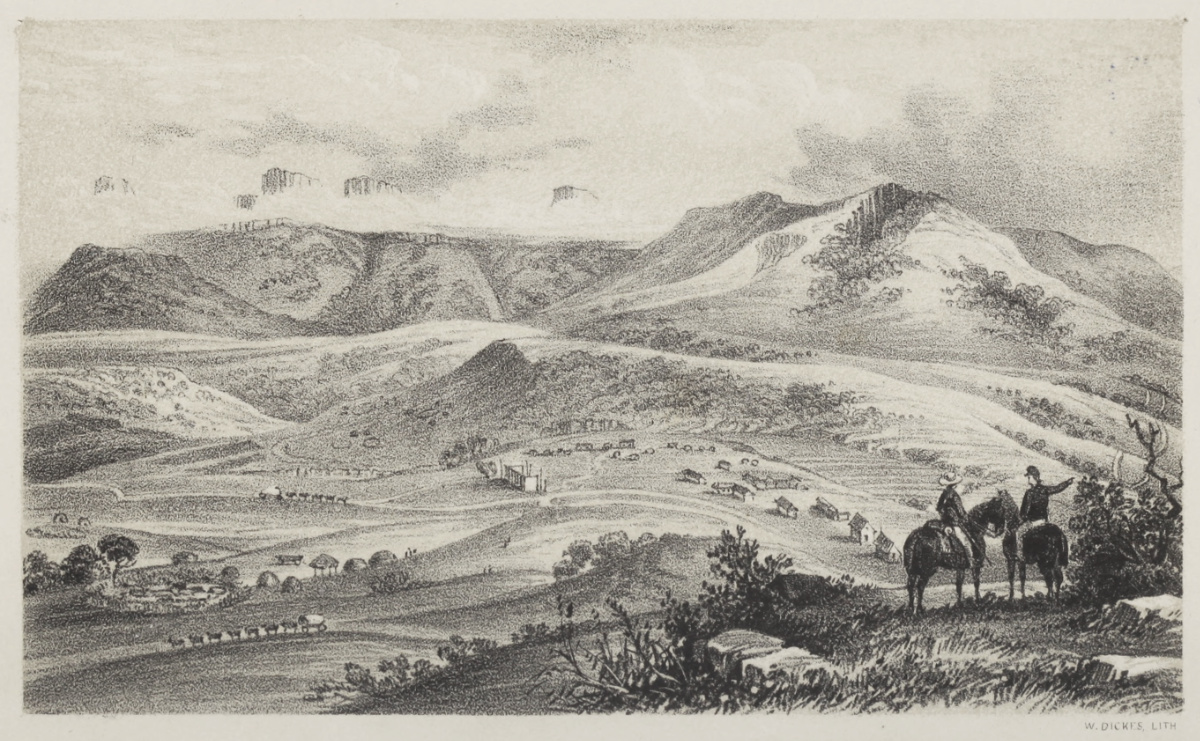
Philipton, Kat River Settlement, South Africa. Illustration from J. J. Freeman, A Tour in South Africa, with Notices of Natal, Mauritius, Madagascar, Ceylon, Egypt, and Palestine (London: John Snow, 1851), frontispiece. Courtesy of the Internet Archive. The Khoekhoe congregation led by the London Missionary Society agent, James Read, was based at Philipton in the Kat River Settlement.
Livingstone complains, moreover, that the verdict had been unduly influenced by "arranged" witnesses whose credibility was in question; he expresses concern at the testimony of "a few Fingoes" (now known as the Mfengu) "who were well known to be the mortal enemies of the whole Hottentot race" (Livingstone 1857bb:[219]). Even more troubling, Livingstone suggests, was the deposition of Khoekhoe convicts when such witnesses would have been deemed "incompetent to act as such in a case of treason at Westminster" (Livingstone 1857bb:[220]). He argues that their testimony had been swayed by the prospect of commuted sentences:
the witnesses may fairly be supposed to have been somewhat influenced by the removal of their chains just before entering into court, to give evidence as much in favour of the side for which they were called as possible – Some indeed confessed afterward that they had indulged the hope that the irons were not to be resumed[.] (Livingstone 1857bb:[220])
The evidence used to indict Botha ultimately appears flimsy to Livingstone. Only a "single breach of duty" had been proven and for that, writes Livingstone, Botha's "forty years of service counted as nothing and he was sentenced to death as a rebel" (Livingstone 1857bb:[221]); Botha's sentence was later reduced to hard labour.
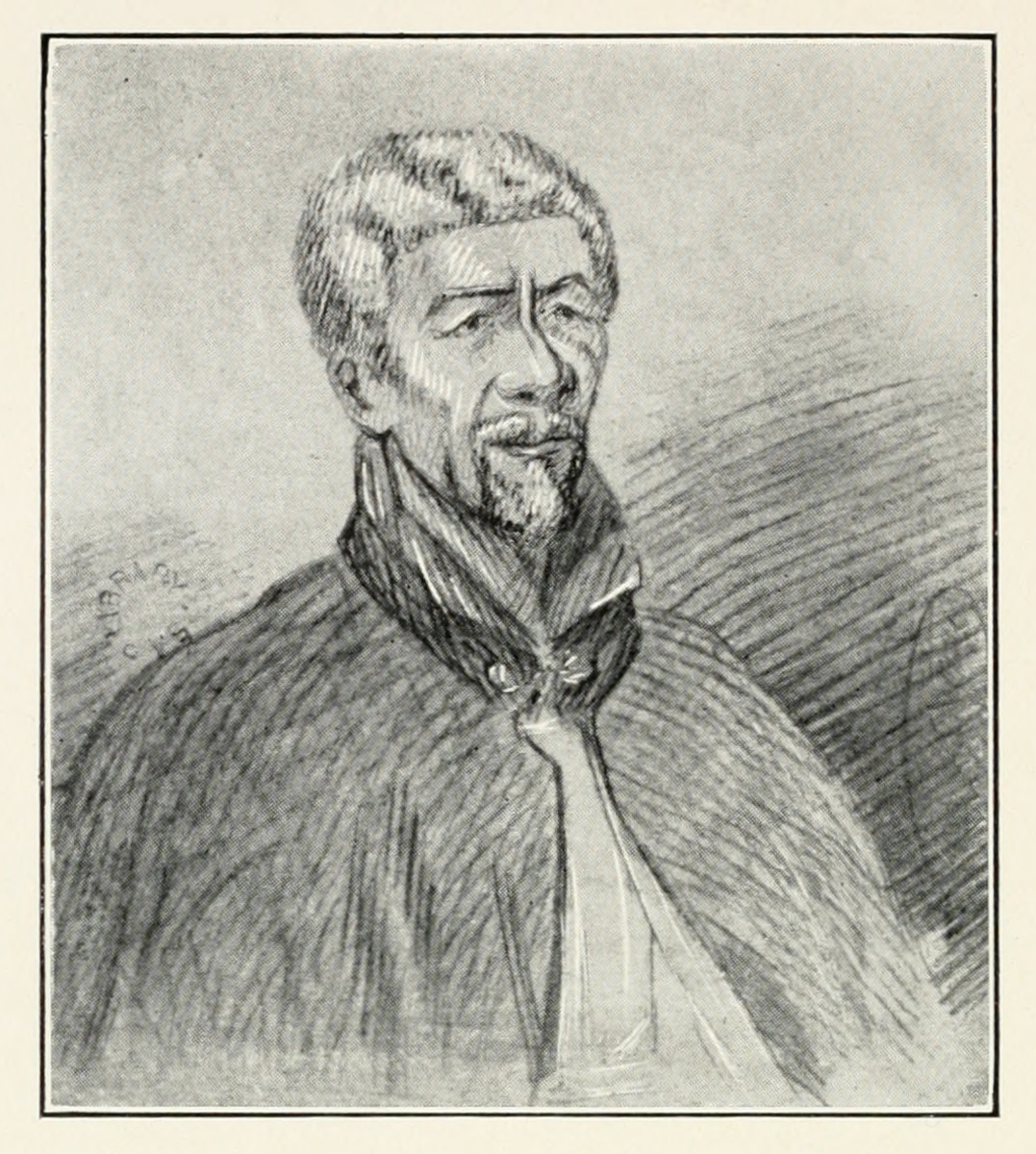
Andries Botha. Illustration from Geo. E. Cory, The Rise of South Africa: A History of the Origin of South African Colonisation and its Development Towards the East from the Earliest Times to 1857, 6 vols (London: Longmans, Green and Co., 1930), 5:opposite 343. Courtesy of the Internet Archive. Andries Botha was a Khoekhoe leader and Veldcornet of the Kat River. He was initially condemned to execution for his alleged involvement in the Kat River Rebellion, but subsequently had his sentence commuted.
Although opinions differ amongst historians over Botha's role in the Kat River rebellion, recent commentators suggest that he was probably innocent. Elizabeth Elbourne, for instance, argues that aside from "at most a few days of flirtation with rebellion," Botha remained loyal to the crown. Noting irregularities in the proceedings and the "vacuity of specific charges," Elbourne suggests that the hearing was really a "political show trial" that made an example of a distinguished settlement resident. The judgement on Botha, she indicates, was not just a condemnation of an individual but was regarded as a "condemnation of the LMS" (Elbourne 2002:367, 372, cf. McDonald 2010:530).
Livingstone clearly detected that his own missionary society was on trial alongside Botha. Having perceived that "the point of most importance in this trial was – the causes of the Kaffir war and Hottentot rebellion" and that the "British settlers" had sought the "conviction of the missionaries," Livingstone responded in kind (1857bb:[221], [223]). In the repressed passage, he instead attributes blame for the Frontier Wars and the Kat River Rebellion to white settlers and the colonial government, and casts his own judgement on the Cape judicial system that had so readily judged Botha.
▲ 4.5. Livingstone's Self-Censorship
In its original draft, Livingstone clearly intended Missionary Travels to provide a major statement on colonial politics and warfare in South Africa. His correspondence, in turn, provides only fleeting insight into the decision to excise this major section. Writing to John Murray on 6 April 1857, Livingstone notes briefly that he has "curtailed the Caffre war subject and sweetened it" (1857k).
Livingstone is somewhat more forthright to Joseph B. Braithwaite, a barrister and influential evangelical Quaker who remained a friend and correspondent until Livingstone's death in 1873 (Milligan 2004; Blaikie 1880:229). In a letter of 4 April 1857, Livingstone tells this trusted advisor: "I did write out a pretty full view of Kaffir wars and denounced the party which has become enriched by a state of warfare." But the result, Livingstone adds, appeared "too much like the declamation of a violent partizan [sic]" (1857a, Petrusic 2002:242). It was this concern about public appearance that, presumably, formed the grounds for the passage's excision.
Livingstone must have been aware that his views could prove controversial. In defending the AmaXhosa and Khoekhoe, he would certainly have been part of a minority opinion in Britain. Although there was public frustration at the expense of colonial conflicts, British press reports of the Eighth Frontier War were generally "pro-colonial." For the most part, sympathy with the AmaXhosa and Khoekhoe was the preserve of the Aborigines' Protection Society and its official publication, The Colonial Intelligencer, or, Aborigines' Friend (Elbourne 2002:370-71).
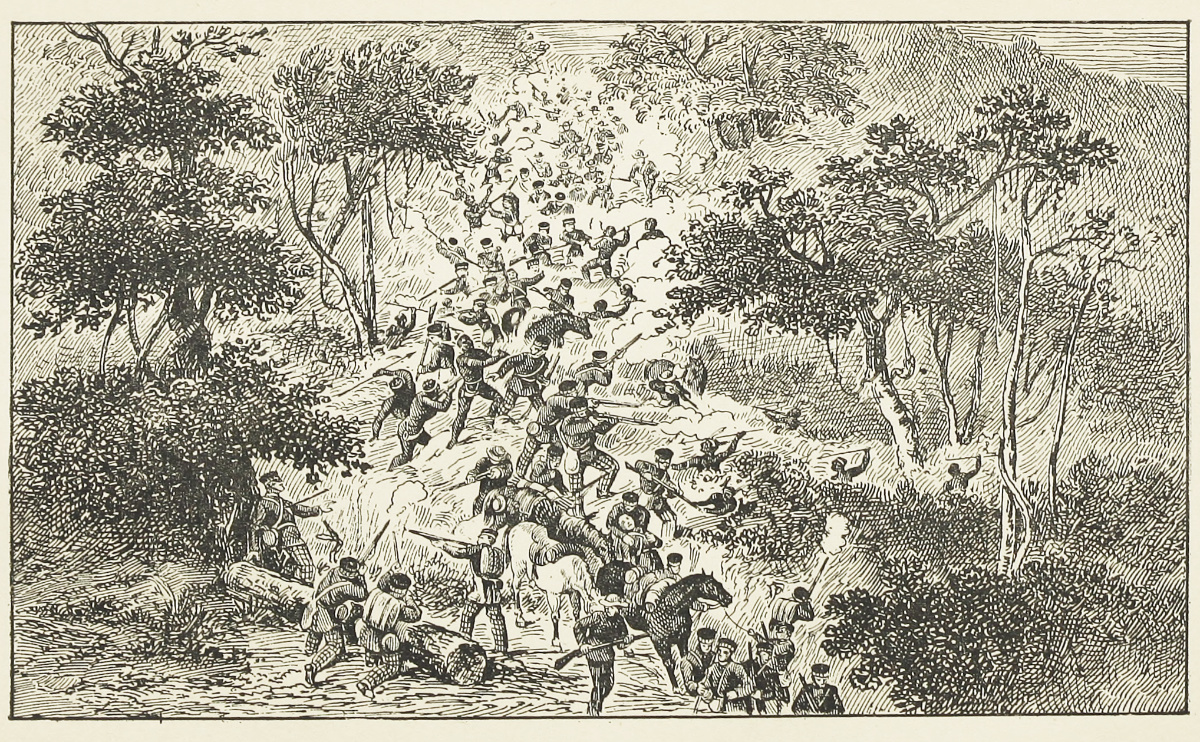
Attack of the Kaffirs on the Troops Under the Command of Lt.-Col. Fordyce of the 74th Highlanders. Illustration from Duncan Campbell Francis Moodie, The History of the Battles and Adventures of the British, the Boers, and the Zulus, &c., in Southern Africa, 2 vols (Cape Town: Murray & St. Leger, 1888), 2:opposite 49. Courtesy of the Internet Archive. This scene commemorates the stand of the 74th Highlanders against an AmaXhosa ambush that took place in September 1851, during the Eighth Cape Frontier War, as the British regiment withdrew following an incursion into the Waterkloof Highlands of the Eastern Cape. The illustration thus valorises British defence against the guerrilla tactics of the AmaXhosa forces.
Livingstone's excised section might have been at home in that sort of abolitionist venue, where he would have found a broadly receptive readership. But such material, which could be read as anti-colonial and anti-British, ran the risk of alienating the wider audience that Livingstone was hoping to attract for Missionary Travels and of jeopardising his prospective plans.
When Livingstone decided to remove the passage in April 1857, he was in the process of securing his government-funded position as "roving" consul in central Africa. He was also in conversation with Roderick Murchison (the president of the Royal Geographical Society) and the Earl of Clarendon (the Foreign Secretary) about his next expeditionary venture on the Zambezi (Jeal 2013:170-71).
In this context, it is not surprising that Livingstone deemed it politically injudicious to appear as a "violent partizan [sic]" who was prepared to sympathise with an anti-colonial insurgency. In May 1857, moreover, a major uprising would break out in another part of the colonial world: the Indian Rebellion, an event that was precipitated by a sepoy "mutiny" against the British East India Company. Given the enormous public turmoil that accompanied the news of violence perpetrated against British soldiers and civilians, Livingstone's decision to repress his passage was undoubtedly timely.
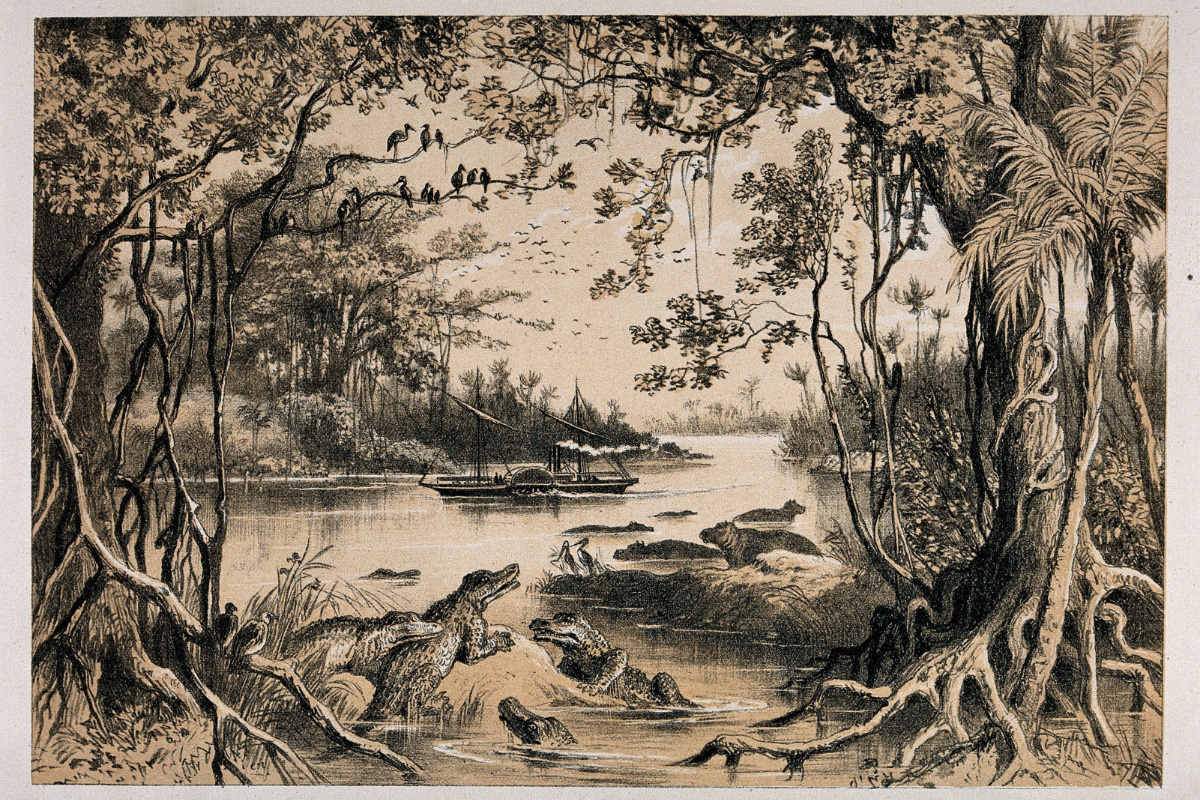
The Ma-Robert on the Zambesi. Copyright Wellcome Library, London. Creative Commons Attribution 4.0 International. While he worked on Missionary Travels in 1857, Livingstone also made arrangements for a major government-supported journey to central Africa: the Zambezi Expedition (1858-64). On this expedition, Livingstone led a team of six Europeans with the remit of investigating the natural resources and opportunities for British trade on the Zambezi River. The Ma-Robert was a steamer built by Macgregor Laird for river transportation, but which proved unsatisfactory in navigating shallow sections of the Zambezi.
Ultimately, Livingstone would combine excision of "The Cape Colony" passage with lesser acts of redaction on the subject of the Cape Frontier Wars (e.g., 1857bb:[251], [263], 1857cc:[111]). Nevertheless, the pattern of political tempering still allowed for several brief but barbed comments to remain. In the published Missionary Travels, for instance, Livingstone complains that Britain had "engaged in most expensive wars without inquiring whether any of the fault lay with our frontier colonists" and adds that "[i]f some border colonists had the absolute certainty of our government declining to bear them out in their arrogance, we should probably hear less of Caffre insolence" (Livingstone 1857aa:370, 372, c.f. 422).
While Livingstone engaged in a large-scale act of political redaction, he was reluctant to expunge his critical perspectives altogether. For instance, when telling Braithwaite that he had cut his "full view of Kaffir wars," Livingstone claimed to have replaced it with "a milder & shorter statement of the case in which the true originators of the wars are plainly indicated" (1857a). Livingstone was probably referring to a statement that he appended to the galley proofs in which he commends a "‘Times Special Correspondent' for the next outbreak to explain where the money goes, and who have been benefitted by the blood and treasure expended" (1857dd:[2], 1857aa:93).
| Images of two page from the Missionary Travels manuscript (Livingstone 1857dd:[197]-[198]). Copyright National Library of Scotland and Dr. Neil Imray Livingstone Wilson (as relevant). Creative Commons Share-alike 2.5 UK: Scotland. These manuscript pages open Livingstone's long passage (later redacted) on the “The Cape Colony,” in which he discusses the Cape Frontier Wars and the Kat River Rebellion. |
The residual presence of these comments in the published text indicates Livingstone's struggle to balance his political convictions with political expediency. His decision to avoid a substantial intervention on the Cape Frontier Wars radically diminished the politically contentious nature of Missionary Travels, but he still made some space for a circumscribed and submerged critique that could appear in print without courting controversy.
Nevertheless, such curtailed remarks are a far cry from Livingstone's original robust and extended commentary on "The Cape Colony." The Missionary Travels manuscript, in turn, provides access to Livingstone's fully developed and complex position on the Cape Frontier Wars. The repressed passage, published in this edition for the first time, offers sustained insight into Livingstone's opposition to recent colonial policies, his vigorous defence of the AmaXhosa, and his pronounced support of the Khoekhoe community in the Kat River Settlement.
5. Conclusion Top⤴
There are, of course, numerous other alterations to Missionary Travels that appear in comparative analysis. Livingstone's manuscript contains, for example, an apocryphal anecdote about his great grandfather's death at the Battle of Culloden (1857bb:[6]), a comparison between BaKwena rainmaking and British homeopathy (1857bb:[48]), and a disquisition on the rights of missionaries to participate in trade (in which Livingstone makes some scathing remarks about colonial traders) (1857cc:[78]-[80]). None of these passages are printed in the published text.
While such redactions warrant further analysis, the present essay has sought to identify the most significant transformations and has singled out the patterns of editorial revision that most profoundly shaped the book. The editing of Missionary Travels was primarily a conservative process: the combined efforts of Livingstone and his editors to prepare the book for publication inclined on the whole towards moderation and circumspection. Put another way, Missionary Travels – like many travel books – was subjected to the protocols of politesse. This process of sanitisation was motivated by reputational considerations and commercial imperatives. Livingstone and his publisher John Murray, in short, collaborated to ensure Missionary Travels would not violate genteel expectations of taste and decorum.
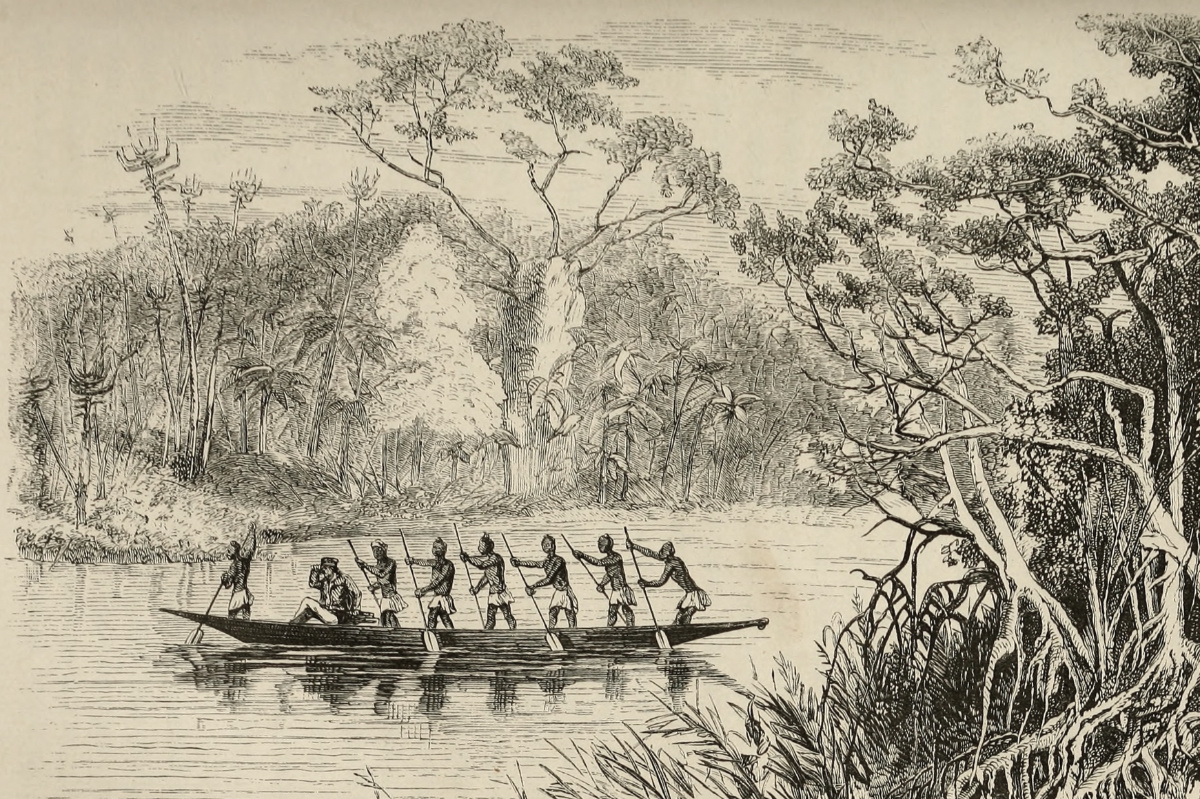
River Scenery on the West Coast. From a Sketch by Capt. H. Need, R. N. Illustration from Missionary Travels (Livingstone 1857aa:opposite 332), detail. Courtesy of the Internet Archive. The illustrations included in Missionary Travels contributed to the book’s popularity and helped establish the iconic imagery that would become associated with Livingstone. For instance, some of the book’s illustrations, including the scene above, provided the basis for a series of magic lantern slides published by John Murray (c.1857). The "Associated Images and Texts" section of the present edition includes images of these slides.
But Missionary Travels was not simply refined according to the conventions of polite publishing; the manuscript was also tempered politically. Although the published narrative did make an emphatic statement on the Transvaal, the additional material in the original manuscript shows that Livingstone both reduced the space he would afford to this critique and avoided expressing some of his more extreme statements.
Yet more consequential was the repression of Livingstone's extended commentary on the Frontier Wars and the Kat River Rebellion. Removing this passage was a major act of depoliticization, which drastically curtailed the book's critical intervention on the Cape Colony and colonial warfare. The excision shows that at a significant moment in his career, Livingstone was concerned about the impact that this passage would have on his book's reception – a concern that his conservative publisher probably shared. By domesticating some of the book's most radical ideas, Livingstone's efforts to sanitize and depoliticize Missionary Travels made it more palatable to key establishment interest groups, reduced the risk of public controversy, and laid the groundwork for his narrative to become a best-selling publishing sensation.
6. Works Cited Top⤴
[View a full list of items cited in this critical edition in the project bibliography.]
Bain, William. 2003. Between Anarchy and Society: Trusteeship and the Obligations of Power. Oxford: Oxford University Press.
Bell, Bill. 2013. "Authors in an Industrial Economy: The Case of John Murray's Travel Writers." Romantic Textualities: Literature and Print Culture, 1780–184021: 9-29.
Blaikie, William Garden. 1880. The Personal Life of David Livingstone. London: John Murray.
Blaikie, William Garden. 1881. The Personal Life of David Livingstone. Second edition. London: John Murray.
Bosch, D. J. 1984. "The Roots and Fruits of Afrikaner Civil Religion." In New Faces of Africa: Essays in Honour of Ben (Barend Jacobus) Marais, edited by J. W. Hofmeyr, & W. S. Vorster, 14-35. Pretoria: University of South Africa.
Bosman, Hendrik. 2014. "The ‘Jerusalemgangers' as an Illustration of Resistance Against the British Empire and Nineteenth Century Biblical Interpretation in Southern Africa." In In the Name of God: The Bible in the Colonial Discourse of Empire, edited by C. L. Crouch and Jonathan Stökl, 151-68. Leiden: Brill.
Cavanagh, Edward. 2011. The Griqua Past and the Limits of South African History, 1902-1994. Oxford: Peter Lang.
Colonial Intelligencer, or, Aborigines' Friend. 1847-66. London.
Comaroff, Jean, and John Comaroff. 1991. Of Revelation and Revolution: Christianity, Colonialism, and Consciousness in South Africa. Chicago: University of Chicago Press.
Dawson, Gowan. 2007. Darwin, Literature and Victorian Respectability. Cambridge: Cambridge University Press.
Davenport, T. R. H., and Christopher Saunders. 2000. South Africa: A Modern History. Fifth Edition. Basingstoke: Macmillan.
Elbourne, Elizabeth. 2002. Blood Ground: Colonialism, Missions, and the Contest for Christianity in the Cape Colony and Britain, 1799-1853. Montreal & Kingston: McGill-Queen's University Press.
Etherington, Norman. 2001. The Great Treks: The Transformation of Southern Africa, 1815–1854. Harlow; New York: Longman.
Giliomee, Hermann. 2003. The Afrikaners: Biography of a People. London: C. Hurst & Co.
Huggins, Mike J. 2000. "More Sinful PLeasures? Leisure, Respectability and the Male Middle Classes in Victorian England." Journal of Social History 33 (3): 585-600.
Jeal, Tim. 2013. Livingstone: Revised and Expanded Edition. New Haven, CT; London: Yale University Press.
Johnson, David. 2012. Imagining the Cape Colony: History, Literature, and the South African Nation. Edinburgh: Edinburgh University Press.
Keighren, Innes M., Charles W. J. Withers, and Bill Bell. 2015 Travels into Print: Exploration, Writing, and Publishing with John Murray, 1773–1859 Chicago: University of Chicago Press.
Kirk, Tony. 1973. "Progress and Decline in the Kat River Settlement, 1829-1854." The Journal of African History 14 (3): 411-28.
Laband, John. 2005. The Transvaal Rebellion: The First Boer War, 1880–1881. Harlow: Pearson Longman.
Legassick, Martin. 2010. The Politics of a South African Frontier: The Griqua, the Sotho-Tswana and the Missionaries, 1780-1840. Basel: Basler Afrika Bibliographien.
Lester, Alan. 2001. Imperial Networks: Creating Identities in Nineteenth-Century South Africa and Britain. London; New York: Routledge.
Livingstone, David. 1852-53. Essay on the Eighth Frontier War and the Xhosa Chief Sandile. LI 1/1/1. National Archives of Zimbabwe.
Livingstone, David. 1857a. Copy of Letter to Joseph B. Braithwaite. 4 Apr. 1857. MS. 10769. National Library of Scotland, Edinburgh, Scotland.
Livingstone, David. 1857k. Letter to John Murray III. 6 Apr. 1857. MS. 42420, ff. 12-15. National Library of Scotland, Edinburgh, Scotland.
Livingstone, David. 1857aa. Missionary Travels and Researches in South Africa. London: John Murray.
Livingstone, David. 1857bb. Missionary Travels and Researches in South Africa (Part I). Jan.-Oct. 1857. MS. 42428. National Library of Scotland, Edinburgh, Scotland.
Livingstone, David. 1857cc. Missionary Travels and Researches in South Africa (Part II). Jan.-Oct. 1857. MS. 42429. National Library of Scotland, Edinburgh, Scotland.
Livingstone, David. 1857dd. Missionary Travels and Researches in South Africa (Part III). Jan.-Oct. 1857. MS. 10702. National Library of Scotland, Edinburgh, Scotland.
Livingstone, David. 1974a. Essay on the South African Boers and Slavery. 1853. In David Livingstone: South African Papers 1849–1853, edited by Isaac Schapera, 70-95. Cape Town: Van Riebeeck Society.
Livingstone, David. 1974b. Essay on the "Peace Makers of the Interior of South Africa" (i). 1849. In David Livingstone: South African Papers 1849–1853, edited by Isaac Schapera, 6-15. Cape Town: Van Riebeeck Society.
Livingstone, David. 1974c. Essay on the "Peace Makers of the Interior of South Africa" (ii). 1849. In David Livingstone: South African Papers 1849–1853, edited by Isaac Schapera, 16-20. Cape Town: Van Riebeeck Society.
Livingstone, Justin D. 2014. Livingstone's "Lives": A Metabiography of a Victorian Icon. Manchester: Manchester University Press.
Martin, Ged. 2008. "Grant, Charles, Baron Glenelg (1778–1866)." Online edition. Oxford Dictionary of National Biography. Oxford: Oxford University Press.
McDonald, Jared. 2010. "James Read: Towards a New Reassessment." South African Historical Journal 62 (3): 514-33.
Milligan, Edward H. 2004. "Braithwaite, Joseph Bevan (1818–1905)." Online edition. Oxford Dictionary of National Biography. Oxford: Oxford University Press.
Moffat, Robert. 1842. Missionary Labours and Scenes in Southern Africa. London: John Snow.
Morton, Fred. 1992. "Slave-Raiding and Slavery in the Western Transvaal After the Sand River Convention." African Economic History 20: 99-118.
Parsons, Neil. 1998. King Khama, Emperor Joe, and the Great White Queen: Victorian Britain Through African Eyes. Chicago: University of Chicago Press.
Petrusic, Christopher G. 2002. "I Could Not Bear to be Beaten by Difficulties": Exploring David Livingstone and Questions of Manliness, Race and Colonialism in Nineteenth-Century Africa and Britain. PhD diss., Carleton University, Ottawa Ontario.
Petrusic, Christopher. 2004. "Violence as Masculinity: David Livingstone's Radical Racial Politics in the Cape Colony and the Transvaal, 1845-1852." The International History Review 26 (1): 20-55
Ramsay, Jeff. 1991. "The Batswana–Boer War of 1852-53: How the Batswana Achieved Victory." Botswana Notes and Records 23: 193-207.
Ramsay, Jeff. 2014. "Firearms in Nineteenth-Century Botswana: The Case of Livingstone's 8-Bore Bullet." South African Historical Journal 66 (3): 440-69.
Ross, Andrew. 2002. David Livingstone: Mission and Empire. London: Hambledon Continuum.
Ross, Robert. 2003. "Ambiguities of Resistance and Collaboration on the Eastern Cape Frontier: The Kat River Settlement 1829-1856." In Rethinking Resistance: Revolt and Violence in African History, edited by Jon Abbink, Mirjam de Bruijn, and Klaas van Walraven, 117-40. Leiden: Brill.
Schapera, Isaac. 1960b. "Livingstone and the Boers." African Affairs 59 (235): 144-56.
Schapera, Isaac, ed. 1974. David Livingstone: South African Papers 1849–1853. Cape Town: Van Riebeeck Society.
Smuts, J. C. 1930. Africa and Some World Problems. Oxford: Clarendon.
Toit, André du. 1983. "No Chosen People: The Myth of the Calvinist Origins of Afrikaner Nationalism and Racial Ideology." The American Historical Review 88 (4): 920-52.
Traill, A. 1995. "The Khoesan Languages of South Africa." In Language and Social History: Studies in South African Sociolinguistics, edited by Rajend Mesthrie, 1-18. Cape Town & Johannesburg: David Philip.
Vernal, Fiona. 2012. The Farmerfield Mission: A Christian Community in South Africa, 1838–2008. Oxford; New York: Oxford University Press.
Vetch, R. H., and rev. by John Benyon. 2008a. "Smith, Sir Henry George Wakelyn, Baronet, of Aliwal (1787–1869)." Online edition. Oxford Dictionary of National Biography.
Youngs, Tim. 2002. "Africa / The Congo: The Politics of Darkness." In The Cambridge Companion to Travel Writing, edited by Peter Hulme and Tim Youngs, 156-73. Cambridge: Cambridge University Press.


![John Murray III and Anon., David Livingstone - Boat Scene (Painted Magic Lantern Slide), [1857], detail. Copyright National Library of Scotland, CC BY-NC-SA 2.5 SCOTLAND. John Murray III and Anon., David Livingstone - Boat Scene (Painted Magic Lantern Slide), [1857], detail. Copyright National Library of Scotland, CC BY-NC-SA 2.5 SCOTLAND.](https://livingstoneonline.org:443/sites/default/files/section_page/carousel_images/liv_014067_0001-carousel.jpg)
![Image of two pages from Livingstone's Field Diary XVI (Livingstone 1872h:[2]-[3]). CC BY-NC 3.0 Image of two pages from Livingstone's Field Diary XVI (Livingstone 1872h:[2]-[3]). CC BY-NC 3.0](https://livingstoneonline.org:443/sites/default/files/section_page/carousel_images/liv_000016_0003-carousel.jpg)





![David Livingstone, Map of Lakes Nyassa and Shirwa [1864?], detail. Copyright National Library of Scotland, CC BY-NC-SA 2.5 SCOTLAND; Dr. Neil Imray Livingstone Wilson, CC BY-NC 3.0 David Livingstone, Map of Lakes Nyassa and Shirwa [1864?], detail. Copyright National Library of Scotland, CC BY-NC-SA 2.5 SCOTLAND; Dr. Neil Imray Livingstone Wilson, CC BY-NC 3.0](https://livingstoneonline.org:443/sites/default/files/section_page/carousel_images/liv_000077_0001-tile.jpg)

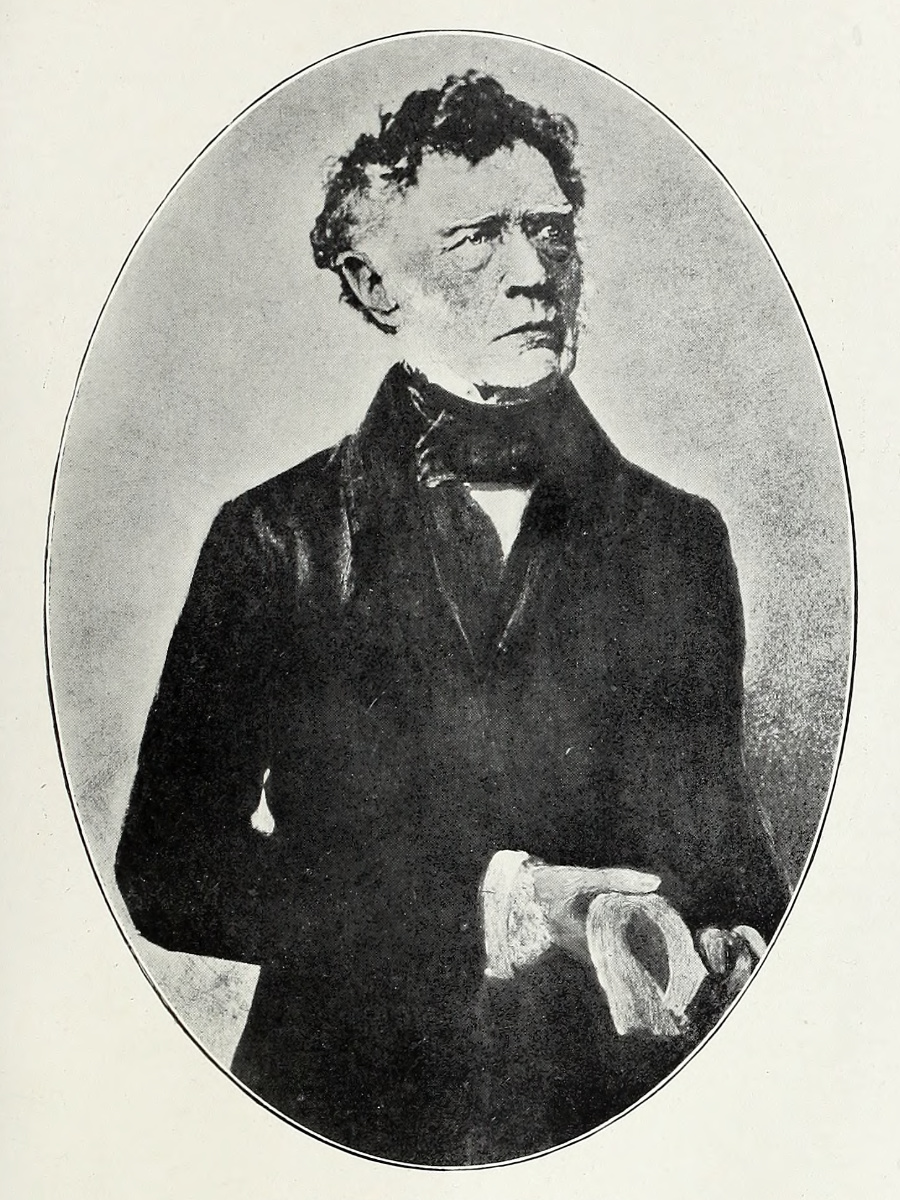
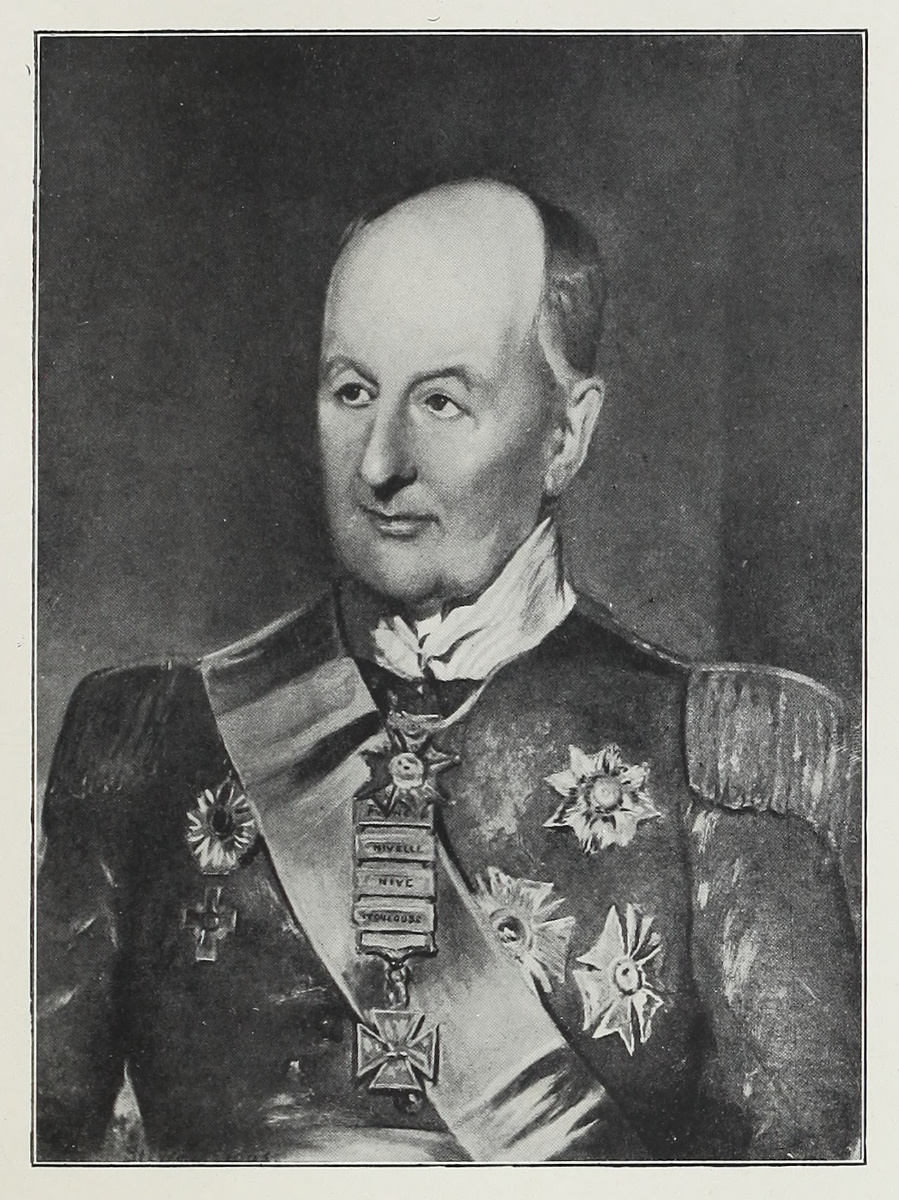
![Image of a page from the Missionary Travels manuscript (Livingstone 1857dd:[197]). Copyright National Library of Scotland and Dr. Neil Imray Livingstone Wilson (as relevant). Creative Commons Share-alike 2.5 UK: Scotland (https://creativecommons.org/licenses/by-nc-sa/2.5/scotland/). Image of a page from the Missionary Travels manuscript (Livingstone 1857dd:[197]). Copyright National Library of Scotland and Dr. Neil Imray Livingstone Wilson (as relevant). Creative Commons Share-alike 2.5 UK: Scotland (https://creativecommons.org/licenses/by-nc-sa/2.5/scotland/).](/sites/default/files/in-his-own-words/missionary-travels-manuscript/missionary-travels-in-pen-and-print-2/liv_000099_0197-article-1200.jpg)
![Image of a page from the Missionary Travels manuscript (Livingstone 1857dd:[198]). Copyright National Library of Scotland and Dr. Neil Imray Livingstone Wilson (as relevant). Creative Commons Share-alike 2.5 UK: Scotland (https://creativecommons.org/licenses/by-nc-sa/2.5/scotland/). Image of a page from the Missionary Travels manuscript (Livingstone 1857dd:[198]). Copyright National Library of Scotland and Dr. Neil Imray Livingstone Wilson (as relevant). Creative Commons Share-alike 2.5 UK: Scotland (https://creativecommons.org/licenses/by-nc-sa/2.5/scotland/).](/sites/default/files/in-his-own-words/missionary-travels-manuscript/missionary-travels-in-pen-and-print-2/liv_000099_0198-article-1200.jpg)